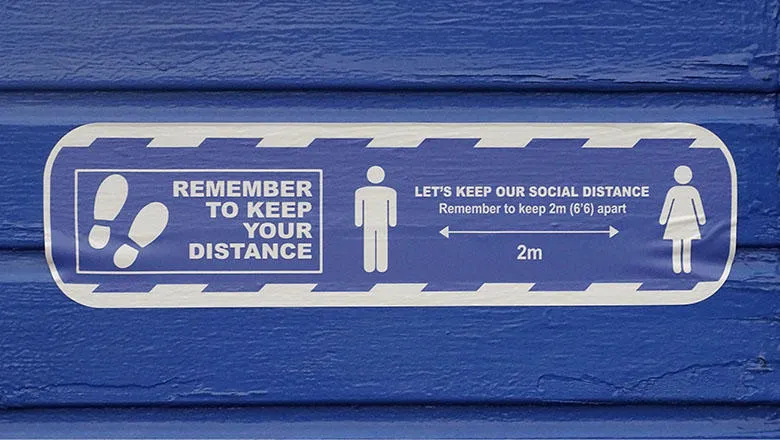26 July 2022
Lockdowns and leaks
Paul Hunter and Julie Brainard
Research suggests government leaks about planned lockdowns may have reduced their effectiveness

The National Institute for Health and Care's Emergency, Preparedness and Response Health Protection Research Unit (EPR HPRU) is a partnership between King’s College London, Public Health England and the University of East Anglia.
This piece is taken from an essay collection showcasing the unit’s critical role in the UK's response to Covid-19.
A key policy response to the global Covid-19 outbreak was the introduction of lockdowns. These varied in severity and length from country to country but were hailed as the primary method of keeping the effective reproduction rate (R rate) down, reducing the spread of the virus and so decreasing the burden on hospitals and healthcare systems and saving lives.
Lockdowns have been shown to have saved millions of lives worldwide, however, this came at a huge financial and mental health cost, which was disproportionately felt among vulnerable groups. As a result, in the UK it was suggested that a more “targeted” or “proportional” approach to restrictions should be taken to continue to keep infections down, while balancing the economic wellbeing, mental health and general welfare of the population.
This was the basis of the UK tier system, announced on 14 October 2020, which introduced a three-tiered system of local Covid-19 Alert Levels. Tiers were set at medium (Tier one), high (Tier two), and very high (Tier three), whereby different tiers were allocated across England depending on the level of Covid-19 infection in the area as determined by the R rate.
The tier system involved the following restrictions:
- Tier one: The “rule of six” – where indoor gatherings in pubs and restaurants are limited to six people – and the closure of hospitality at 10pm.
- Tier two: “Rule of six” for all outdoor hospitality venues and public and private gardens.
- Tier three: Prohibition of social mixing indoors and in private gardens and, closing of indoor and outdoor hospitality venues.
While the initial March lockdown in the UK was found, on base evidence, to be very effective, the subsequent November 2020 lockdown was significantly less so. Specifically, our research suggests that leaks concerning government plans for when new lockdown restrictions would be implemented compromised the effectiveness of the lockdown by fuelling pro-social behaviours.
Our research focussed on the November 2020 lockdown, which aimed to curb rising infection rates and suppress deaths over the winter period. News of the lockdown – that it was coming into effect on 4 November – leaked on October 30 2020 and this appeared to trigger a sharp increase in movement and socialisation.
Tracking data from Google and Citymapper shows that travel in London increased by up to 50 per cent of pre-pandemic travel levels, with a spike between the leak being made public on 30 October, and the beginning of the lockdown on 4 November. The level of movement during this period was the highest it had been since 16 March 2020.
The big question is whether the leak, and consequent spike in socialisation, had an impact on the spread of Covid-19.
Using publicly available data on daily Covid-19 cases by local authority (local government areas), we found there was a clear surge in infections from a few days before to several days after the lockdown was implemented. But this surge was almost exclusively associated with authorities where Tier one or Tier two restrictions were being implemented, and was not seen in Tier three areas. We can assume that this is because comparatively fewer freedoms were being removed from people in Tier three, meaning there was less incentive for them to socialise prior to the Tier system being implemented when they were alerted to the imminent lockdown by the leak.
Interestingly, there were clear demographic differences in the surge that cut across all the tiers. When broken down by age group, the November surge in cases was seen most clearly among 20-29-year-olds, and this pattern tracked across all tiers. By contrast, there was no correlating surge in cases among the over 60 age groups.
This suggests that news of the imminent lockdown had less impact on the behaviour of the 60+ group, perhaps reflecting that there was higher adherence to social distancing and shielding in this age group prior to and continuing during lockdown. Towards the end of the lockdown, there was also an increase in cases, which were most prevalent among 10-14-year-olds. This uptick concurred with the emergence of Delta, the new, more infectious strain of Covid-19.
Ultimately, we have inferred through the available mobility and case data, that while lockdown measures were one of the most effective government policies in the early stages of the Covid-19 pandemic at reducing the spread of the virus, subsequent lockdowns were not as effective.
Our research suggests that this may be due to leaks within the UK government in the lead up to the implementation of the tiered system, which undermined their effectiveness. This has important implications for similar public health interventions.
As we saw in the spike in 20-29-year olds going out during the five-day period before the November lockdown, once the public has been primed to the realities of such a stringent policy measure, the effect of subsequent implementation is not as strong, and any notice period will reduce this effect further.
The research conducted by our team demonstrated that it essential that draconian laws are introduced swiftly when needed, and without warning, to ensure greater efficacy.
Paul Hunter is a Professor in Medicine at Norwich Medical School, University of East Anglia. Julie Brainard is a Senior Research Associate at Norwich Medical School, University of East Anglia.
